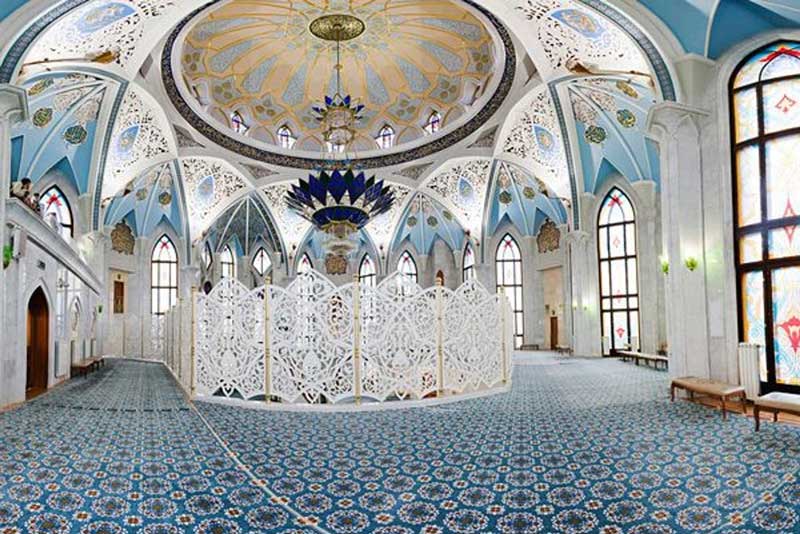
Built on the site of an ancient mosque destroyed by the troops of Ivan the Terrible in 1552, Kul Sharif Mosque is located in the historic citadel of the Kazan Kremlin, in the city of Kazan, the capital of Tatarstan. The lost mosque was also named Kul Sharif Mosque, after the name of the religious scholar and the last great imam of the Khanate of Kazan, a medieval Tatar Turkic state, who sacrificed his life, along with his numerous disciples, while trying to defend Kazan from the invaders. Although nothing is left of the ancient mosque except a few descriptions and drawings, it is estimated that it was a graceful two-storey building featuring 8 minarets, oriented towards the 8 parts of the world, and encompassed a rich library.
However, the decision to construct a new mosque on the site of the ancient mosque under the same name was taken in 1995, and several countries, including Saudi Arabia and the United Arab Emirates, contributed to the fund that was set up for the purpose. The work on the project started with the laying of the foundation stone on 21 February 1996 in the historical complex of the Kazan Kremlin and ended in 2005, just before the celebration of the 1000th anniversary of Kazan.

The Kul Sharif Mosque was erected within the Kazan Kremlin complex, alongside the Annunciation Cathedral, symbolizing the coexistence of the two religions on the same land. While the mosque complex covers an area of around 204,513 sq feet (19,000 sq m), the Kul Sharif Mosque, located in the western part of the Kazan Kremlin, makes a symmetrical composition by making its presence in the centre, flanked by two pavilions. Apart from the mosque, the complex includes a museum, a library, a publishing centre, and an administrative building.
However, with the 187 feet (57 m) tall minarets and the dome fixed at a height of 128 feet (39 m), the Kul Sharif Mosque dominates the sky of the complex. The huge courtyard in front of the mosque is big enough to accommodate approximately 10,000 people, and the interior of the mosque is designed for another 1,500 people.

Strangely, the grand dome of the mosque resembles somewhat like a Kazan Hat, which the commoners used to wear. The traditional interior is decorated with wood engravings, embroidery, and other types of ornamental and artistic decoration, representing the rich tradition of arts and crafts of the Tatar people, and the floors are covered with luxurious handmade Persian carpets.
The praying hall is illuminated by a magnificent centrally located chandelier, made of coloured Bohemian glass, 16`4 feet (5 m) in diameter and weighing two and a half tons, created in the Czech Republic, based on the sketches of the Tatarstan artists, while the floors are covered with luxurious Persian carpets.

The mosque has different zones marked for men and women. While men pray on the first floor, women on the second one, and the tourists are allowed only on the special balconies. The dome of the Mihrab is decorated with an ornamental composition resembling flowery branches interlaced with each other symbolizing the Firdaus or the paradise. Apart from that, there are 90 epithets of the God, made of glass pigmented blue with cobalt oxide, coated with gold leaf, on the top of the stained glass windows, under the dome, and inside the dome.
The five-story mosque looks wonderful at night when illuminated from all sides.